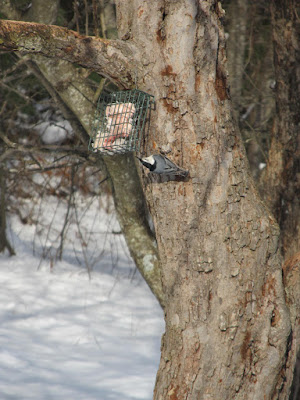Last weekend, birdwatchers from across the globe turned their attention to their own yards to identify species and count their numbers. It's a fun event and regardless of experience, anyone can participate. The best part - you don't have to leave the comfort of your home. The event ran for four days from February 16 - 19. I logged in two to three checklists a day from Saturday thru Monday. The weather changed drastically over the weekend, from sunny and mild to cold with several inches of snow.
|
|
Although it seemed like there were fewer birds at the feeders this year, I did identify 12 individual species. Here is what I saw:
Black-capped Chickadee
Dark-eyed (slate-colored) Junco
By far the most common bird of the weekend were the Juncos, with 14 appearing at one time. They enjoy picking the ground for food, but will also eat from the feeder. Although I can't distinguish the difference, the males are more prominent here in the winter as the females will migrate further south where there is less competition for food (1).
Northern Cardinal
The cardinals never disappoint and have been faithful visitors all winter long. They are also very accepted by other birds as is evident from their willingness to share the feeder with smaller birds.
Blue Jay
Tufted Titmouse
Mourning Dove
The unobtrusive Mourning Dove is a soulful bird. When not feeding underneath the feeders, they are often seen keeping a watchful eye from the roof of our house. Unfortunately, due to their abundance, around 40 states allow hunting of doves. I am happy that New Hampshire is not one of them.
Suet attracts many birds, but is a favorite of woodpeckers in the winter. We typically have three species that visit regularly.
Red-bellied Woodpecker
A bird that has gradually expanded its range north, the red belly of this woodpecker is more difficult to see than it's red nape.
Downy Woodpecker
 |
| Male Downy Woodpecker |
Hairy Woodpecker
 |
| Hairy Woodpecker-Male |
At a quick glance, it may be difficult to distinguish between the Downy and the Hairy Woodpecker. But once you see them together, you will notice the size difference. Not only is the Hairy about three inches longer, its bill is also larger. In both species, only the male has a red patch on the top of its head.
Although not a woodpecker, the behavior of nuthatches is similar, climbing up and down trees searching for food. Nuthatches often travel facing downward. Unlike woodpeckers which use their tail to assist, they climb using only their feet. They are also are one of the few species of birds that have been observed using a tool to assist with feeding. They may take a piece of bark and use it to excavate for food on the trunk of a tree (1).
Sparrows are one of those birds that may be easy to disregard. However, each species is unique and worthy of a closer look. Only one sparrow visited the feeder last weekend. In addition to the white throat, this sparrow has an attractive yellow patch over its eyes.
I am not one hundred percent certain of this identification and even though New Hampshire's state bird is the Purple Finch, I believe that the two pairs that visited our feeder last weekend were House Finches. The male House Finch doesn't have a red back and has more distinct stripes on its belly.
Finally, birds were not the only visitors to the feeders. Where we used to have Red squirrels in our back yard, that has changed in recent years to Gray Squirrels which definitely consume more of the food intended for the birds. Although I could do without them, It is fun to watch their agility and acrobatic maneuvers.
The squirrel on the left seems to be patiently waiting his turn, while the one on the right is not in any hurry to finish eating.
And, evidence of increasing winter temperatures, is the fact that a chipmunk was seen below the feeder last weekend. Chipmunks typically hibernate during the winter, only awaking every few days, to eat food they have stashed and to defecate. A study at Fordham University (2) observed that as winter temperatures warmed, some chipmunks did not hibernate or awoke earlier from hibernation. Unfortunately, for those that did not hibernate, they did not survive the winter. A sobering thought for other hibernating species as global temperatures warm.
Footnote:
(1) The Sibley Guide to Bird Life & Behavior, David Allen Sibley, 2001
(2) https://legacy.fordham.edu/campus_resources/enewsroom/archives/archive_1094.asp
White-throated Sparrow
Sparrows are one of those birds that may be easy to disregard. However, each species is unique and worthy of a closer look. Only one sparrow visited the feeder last weekend. In addition to the white throat, this sparrow has an attractive yellow patch over its eyes.
House Finch
Finally, birds were not the only visitors to the feeders. Where we used to have Red squirrels in our back yard, that has changed in recent years to Gray Squirrels which definitely consume more of the food intended for the birds. Although I could do without them, It is fun to watch their agility and acrobatic maneuvers.
And, evidence of increasing winter temperatures, is the fact that a chipmunk was seen below the feeder last weekend. Chipmunks typically hibernate during the winter, only awaking every few days, to eat food they have stashed and to defecate. A study at Fordham University (2) observed that as winter temperatures warmed, some chipmunks did not hibernate or awoke earlier from hibernation. Unfortunately, for those that did not hibernate, they did not survive the winter. A sobering thought for other hibernating species as global temperatures warm.
 |
| Chipmunks should not be out and about in February |
(1) The Sibley Guide to Bird Life & Behavior, David Allen Sibley, 2001
(2) https://legacy.fordham.edu/campus_resources/enewsroom/archives/archive_1094.asp
















No comments:
Post a Comment